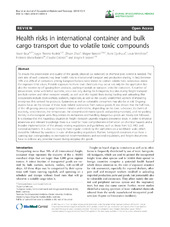| dc.description.abstract | To ensure the preservation and quality of the goods, physical (i.e. radiation) or chemical pest control is needed. The dark side of such consents may bear health risks in international transport and production sharing. In fact, between 10% and 20% of all containers arriving European harbors were shown to contain volatile toxic substances above the exposure limit values. Possible exposure to these toxic chemicals may occur not only for the applicators but also the receiver by off gassing from products, packing materials or transport units like containers. A number of intoxications, some with lethal outcome, occur not only during the fumigation, but also during freight transport (on bulk carriers and other transport vessels), as well as in the logistic lines during loading and unloading. Risk occupations include dock-workers, seafarers, inspectors, as well as the usually uninformed workers of importing enterprises that unload the products. Bystanders as well as vulnerable consumers may also be at risk. Ongoing studies focus on the release of these toxic volatile substances from various goods. It was shown that the half-lives of the off-gassing process range between minutes and months, depending on the toxic substance, its chemical reactivity, concentration, the temperature, the contaminated matrix (goods and packing materials), and the packing density in the transport units. Regulations on declaration and handling dangerous goods are mostly not followed. It is obvious that this hazardous situation in freight transport urgently requires preventive steps. In order to improve awareness and relevant knowledge there is a need for more comprehensive information on chemical hazards and a broader implementation of the already existing regulations and guidelines, such as those from ILO, IMO, and national authorities. It is also necessary to have regular controls by the authorities on a worldwide scale, which should be followed by sanctions in case of disregarding regulations. Further, fumigated containers must have a warning sign corresponding to international recommendations and national regulations, and freight documents have to indicate any potential hazard during stripping the goods. | en_US |

